Fuzzy succulents are cute, easy to grow, relatively cheap, and quickly adapted to any home. So they are also suitable for people who need to learn how to grow and care for plants.
If you want to be the happy owners of fuzzy succulents, I have prepared a huge list of 20 species of succulents from which you can choose your next plant (or plants, I don’t judge 😉)
Succulents with fuzzy leaves or stems are also known as fuzzy succulents or fuzzy-leaved succulents. They are succulent plants with soft, hairy, or fuzzy leaves or stems. Unlike other succulent types, these plants are distinguished by their shaggy appearance.
1. Pickle Plant (Delosperma echinatum)
Pickle Plants are fascinating and unique succulents native to South Africa, called Delosperma echinatum, scientifically. This plant produces dense, spreading mats of succulents. Its leaves are cylindrical and finger-like, with bristles-like white hairs covering them, giving them an almost fuzzy appearance. The Pickle Plant is named after small pickles or sea urchins because of its leaves. The hairs on the leaves protect the plant from intense sunlight and reduce water loss. Yellow or white flowers can be produced.
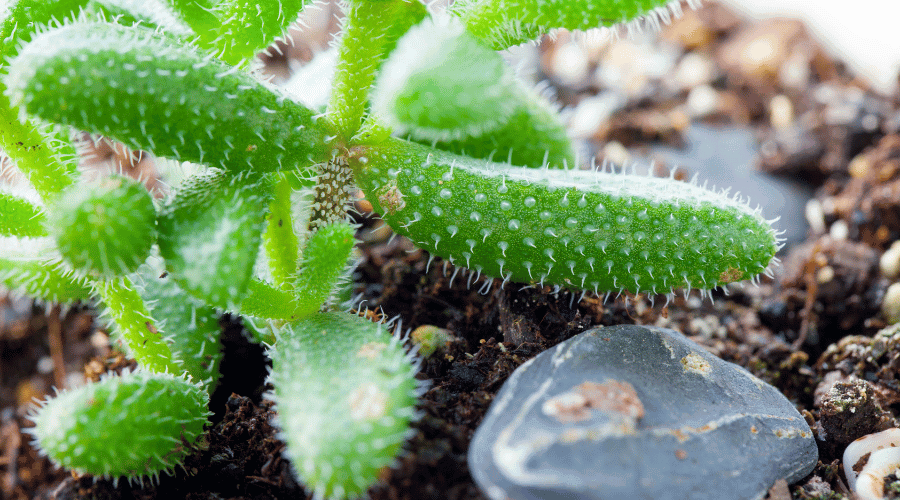
Here’s how to keep Pickle Plant healthy:
- Sunlight: The Delosperma echinatum prefers bright, direct full sun for several hours daily. Place it in a bright, filtered spot.
- Temperature: It may struggle during extreme heat or frost. It prefers warm temperatures between 65°F (18°C) and 85°F (29°C).
- Soil: Use well-draining soil for succulents or cacti. A sandy or rocky soil mixture with good drainage is essential to prevent root rot.
- Watering: Let the soil dry out between waterings to prevent root rot. The Pickle Plant thrives in drought conditions and requires infrequent watering.
2. Woolly Rose (Echeveria ‘Doris Taylor’)
With dense, white, and fuzzy hairs all over its thick, fleshy leaves, the Woolly Rose forms a rosette. Usually, the leaves are pale green or gray-green and have a woolly texture. They grow compactly up to 6 inches (10 to 15 cm) and look soft and velvety. Plants can be propagated from offsets over time.

Here’s how to keep Woolly Rose healthy:
- Sunlight: Woolly Roses like bright, indirect sunlight or partial shade. They need at least four to six hours of sun a day. Avoid direct sunlight during the hottest hours since it can scorch them.
- Temperature: It prefers moderate temperatures between 60°F (15°C) and 80°F (27°C). Protect it from freezing temperatures, as it is not cold-hardy.
- Soil: Use well-draining soil formulated explicitly for succulents or cacti.
- Watering: the Woolly Rose only needs a little water. Water thoroughly but rarely and let the soil dry out between waterings. Too much water can cause root rot.
- Humidity: The Woolly Rose prefers low moisture and can tolerate dry air.
3. White Velvet (Tradescantia sillamontana)
The white velvet succulent is low-growing, spreading, and can reach a height of 12″ (30 cm). With their fine white hairs, the leaves have a fuzzy, velvety texture. Its leaves are oval-shaped, about 1 to 2 inches long, and vary in color from gray-green to silver-green. They’re usually purple on the underside, which makes them stand out. Although White Velvet is mainly grown for its foliage, it can produce small pink or purple flowers under the right conditions.

Here’s how to keep White Velvet healthy:
- Sunlight: White Velvet thrives in indirect sunlight or partial shade. It can handle some direct sunlight, especially in the morning or late afternoon, but prolonged exposure to intense sunlight may cause leaf burn. For most of the day, you want bright, filtered light.
- Temperature: It likes moderate temperatures between 65°F (18°C) and 80°F (27°C), but it can’t handle intense heat or frost. Be sure to protect it from freezing temperatures.
- Soil: Ideally, you want well-drained soil specifically designed for succulents. A mixture of sandy or potting soil and perlite or pumice works well.
- Watering: White Velvet needs moderate watering. Water when the soil is dry. Let it dry out between waterings. Avoid overwatering to prevent root rot.
- Humidity: White Velvet prefers low humidity levels.
4. Bear’s Paw (Cotyledon tomentosa)
Bear’s Paw is a small, medium-sized succulent that forms a rosette of thick fleshy furry leaves. These leaves are oval-shaped with rounded edges, covered with dense, soft fine hairs, giving them an almost velvety feel. With reddish-brown or maroon markings along the edges, the leaves can vary in color. Bear’s Paw can grow small tubular flowers on tall, slender stems with enough sunlight.
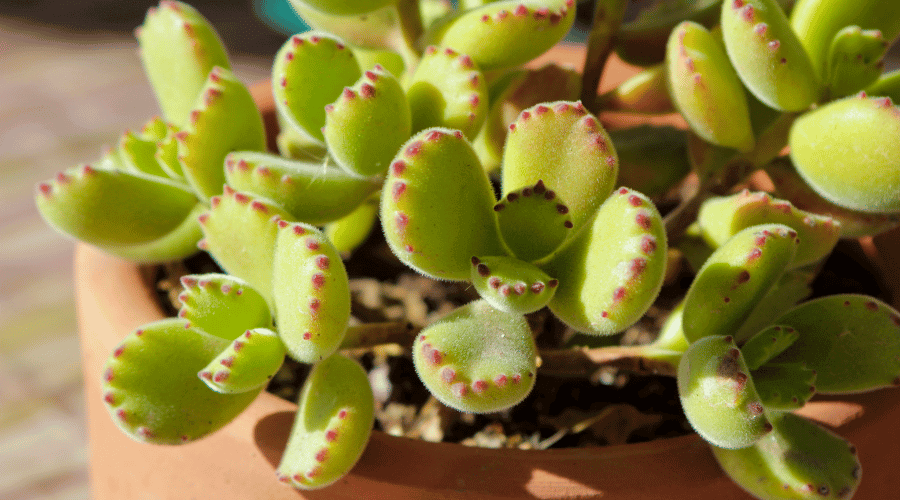
Here’s how to keep Bear’s Paw healthy:
- Sunlight: Ideally, Bear’s Paw needs bright, indirect sunlight to thrive. It prefers four to six hours of daylight a day. Avoid intense, full sun exposure, as it can result in leaf burn. In hot climates, partial shade or filtered sunlight is beneficial.
- Temperature: This plant prefers moderate temperatures between 60°F (15°C) and 80°F (27°C). Protect it from freezing temperatures, as it cannot survive cold temperatures.
- Soil: The soil must be well-drained to allow Bear’s Paw to thrive. Ideally, a mixture of sandy or potting soil and perlite or pumice has been shown to work very well with the plant.
- Watering: The Bear’s Paw has typical succulent water requirements. Water it thoroughly once the top inch (2.5 cm) of soil is dry, and allow it to dry out between waterings. During winter dormancy, watering reduces because overwatering can lead to root rot.
- Humidity: Bear’s Paw prefers low to moderate humidity. It tolerates drier conditions.
5. Copper Spoons (Kalanchoe orgyalis)
With their paddle-shaped leaves, Copper Spoons are known scientifically as Kalanchoe orgyalis. In the winter, it produces clusters of small tubular flowers on tall stems, usually reaching a height of about 1 to 2 feet (30 to 60 cm). The leaves are thick, fleshy, coppery-brown, and velvety in texture. When the leaves mature, a powdery coating enhances their beauty. The edges can be reddish brown.

Here’s how to keep Copper Spoons healthy:
- sunlight: Copper Spoons thrive in bright, indirect sunlight. In hot climates, partial shade or filtered sunlight is helpful, especially if you have four to six hours daily. While it can tolerate some direct sunlight, prolonged exposure to intense sun rays will burn your leaves.
- Temperature: Copper Spoons prefer temperatures between 60°F (15°C) and 80°F (27°C). Keep them away from freezing temperatures since they are not hardy. They can tolerate warm weather, but they may benefit from some shade during the summer.
- Soil: You’ll need soil that drains well, such as sand or potting soil combined with perlite or pumice.
- Watering: Copper Spoons need plenty of water. Water thoroughly when the soil reaches the top inch (2.5 cm). Let it dry out between waterings because overwatering can lead to root rot. Water less during the winter dormancy period.
- Humidity: Ideally, Copper Spoons prefer low to moderate humidity levels, but they can handle dryer conditions as well.
6. Gouty Houseleek (Aichryson tortuosum)
With thick, fleshy leaves, the gritty houseleek forms rosettes. You’ll love its spoon-shaped, slightly curved, elongated leaves. Gouty Houseleek has a unique wavy appearance that makes the plant stand out. As the leaves get more sun, they’ll turn reddish or purplish. It grows to 6 inches (15 cm) and spreads by offsets or side rosettes.

Here’s how to keep Gouty Houseleek healthy:
- Light: Gouty Houseleek thrives in bright, indirect sunlight. It needs four to six hours of daylight a day. Direct sunlight can be tolerated, especially in cooler climates, but excessive exposure may result in leaf damage. It is beneficial to provide partial shade or filtered sunlight in hot climates.
- Temperature: This plant prefers moderate temperatures between 60°F (15°C) and 75°F (24°C). It is not cold-hardy, so protect it from freezing temperatures. It can also tolerate hotter temperatures but may need shade during the hottest months.
- Soil: Gouty Houseleek is well adapted to rocky and gravelly soils due to good drainage. It can also be grown in soil specially formulated for succulents and cacti.
- Watering: Gouty Houseleek requires typical succulent watering. Allow the soil to dry out between waterings by watering it thoroughly once the top inch (2.5 cm) is dry. Overwatering can lead to root rot, so keep it dry. Reduce watering during the winter.
- Humidity: Low to moderate moisture is best for Gouty Houseleek, but drier air is okay too.
7. Mexican Firecracker (Echeveria setosa)
Mexican Firecracker plants grow in rosettes of thick, fleshy leaves. The leaves are spoon-shaped or lanceolate, covered in dense, fine hair, so they feel fluffy. Leaves usually have silvery or white hairs but can also have reddish or brownish hairs. When you’re stressed, the coloration gets better. Rosettes generally come in six inches (15 cm) wide. The plant reaches maturity. It may produce tall flowering stems with small, tubular coral-orange or red flowers.

Here’s how to keep Mexican Firecracker healthy:
- Sunlight: Mexican Firecracker thrives in bright, indirect sunlight. Despite being able to tolerate some direct sunlight, especially in cooler climates, excessive exposure to intense sunlight may burn the leaves. In hot regions, partial shade or filtered sunlight can help.
- Temperature: Mexican Firecracker prefers moderate temperatures between 60°F (15°C) and 80°F (27°C). Protect it from freezing temperatures since it is cold-hardy and can tolerate slightly warmer temperatures, but it may benefit from some shade during the hottest months.
- Soil: A mix of sandy soil, potting soil, and perlite or pumice will make excellent drainage for succulents and cacti.
- Watering: When it’s dry, water it thoroughly. After that, let it dry out between waterings. Overwatering leads to root rot, so don’t leave it waterlogged. Wait to overwater it during the winter.
- Humidity: Mexican Firecrackers prefer low to moderate humidity.
8. Namaqua crassula (Crassula namaquensis)
Namaqua crassula succulent has a cute, low-growing succulent look. It forms dense clumps of compact, upright stems, usually no more than 4 inches (10 cm) tall. The cylindrical stems have tiny, fleshy leaves that cling tightly to them. It has triangular or lanceolate leaves with a grayish-green color with a slight blue tint. When it’s in direct sunlight, the tip of the leaves can get reddish or purplish. Namaqua crassula produces small, star-shaped pale pink or white flowers in spring or summer.
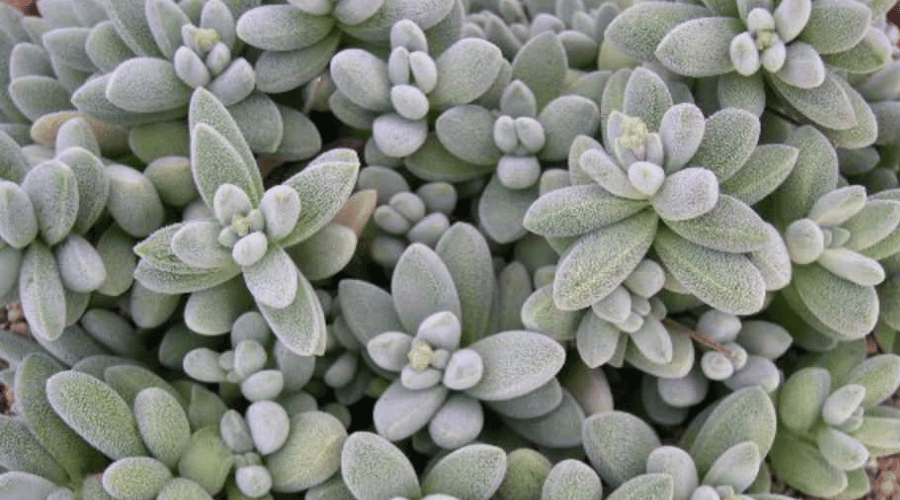
Here’s how to keep Namaqua crassula healthy:
- Sunlight: Indirect, bright sunlight is ideal for Namaqua crassula. It needs at least four to six hours of light a day. It can tolerate some direct sunlight, especially in cooler climates, but excessive sunlight may burn the leaves. Especially in hot places, partial shade or filtered sunlight is nice.
- Temperature: Namaqua crassula prefers temps between 60°F (15°C) and 80°F (27°C). Keep it away from freezing temperatures since it’s not cold-hardy. During the hottest months, it may benefit from shade.
- Soil: Make sure the soil is well-draining. For succulents and cacti, use a mixture of sandy soil and pebbles or pumice for drainage.
- Watering: Namaqua crassula needs typical succulent water. Water it thoroughly when the top inch (2.5 cm) is dry, and let it dry out between waterings. Waterlogged soil can cause root rot, so try not to overwater. Water is less in the winter while the plants are dormant.
- Humidity: Low to moderate moisture is best for Namaqua crassula, but it can also go dry.
9. Red Echeveria (Echeveria coccinea)
A red echeveria is a compact rosette of thick, fleshy leaves. These leaves have spoon or paddle shapes and range in color from green to red, depending on the amount of sun and the environment. When exposed to bright light, the foliage develops intense red tones, particularly along the leaf edges. Some rosettes are up to 6 inches (15 cm) in diameter. In the summer, mature plants produce bell-shaped, red or orange flowers on slender, arching flower stalks.
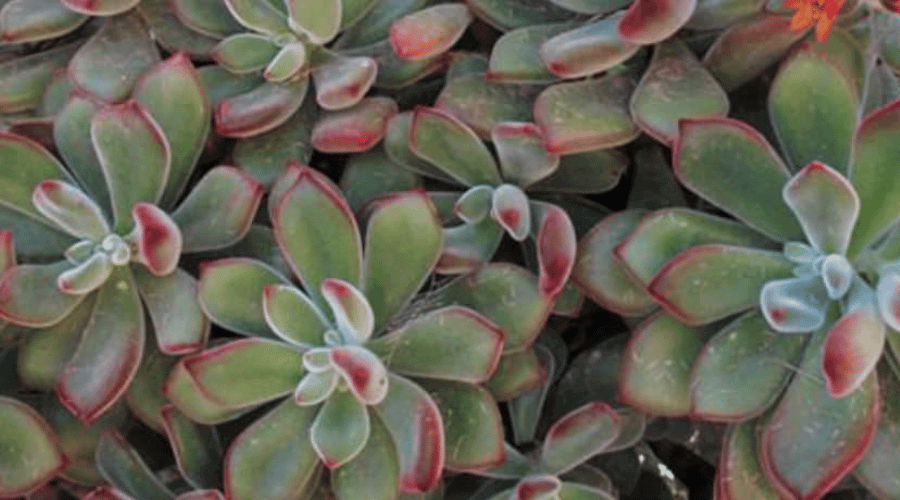
Here’s how to keep Red Echeveria healthy:
- Sunlight: Red Echeveria thrives in bright, indirect sunlight. Although it can tolerate some direct sunlight, especially in cooler climates, excessive exposure to intense rays can cause leaf burn. It prefers four to six hours of daylight each day. Particularly in hot regions, partial shade or filtered sunlight are beneficial.
- Temperature: In terms of temperature, Red Echeveria likes moderate temperatures between 60°F (15°C) and 75°F (24°C). It is not cold-hardy, but you may benefit from shade during the hottest months.
- Soil: Red Echeveria thrives in a well-drained succulent or cacti soil. A mixture of sand and potting soil blended with perlite or pumice is highly recommended.
- Watering: The soil’s top inch (2.5 cm) must be completely dry before watering the plant. Allow the soil to dry between waterings during dormancy periods.
- Humidity: Low to moderate moisture is preferred by Red Echeveria, though it can tolerate air that is drier as well.
10. Jersey Pigmyweed (Crassula pubescens)
Another popular houseplant is Jersey Pigmyweed, a small succulent native to South Africa. Crassula pubescens is also known as the Velvet Leaf Crassula or Jersey Pigmyweed. The small oval-shaped leaves are covered in fine, fuzzy hairs, making them velvet or fuzzy. Crassula pubescens is a low-growing succulent that typically forms dense mats and clusters. During the warmer months, the plant grows small, delicate white or pale pink flowers on tall, slender stems. The leaves are generally green or grayish-green but can change to reddish or purple when exposed to bright sunlight.
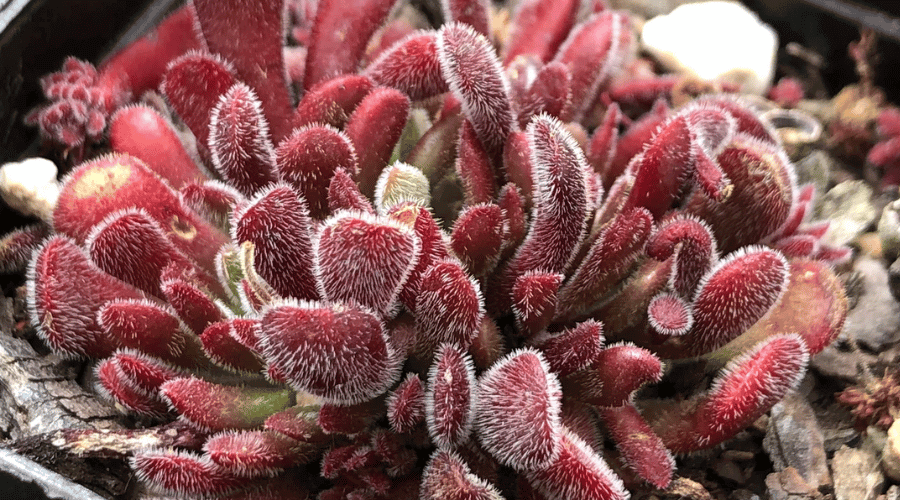
Here’s how to keep Jersey Pigmyweed healthy:
- Light: Crassula pubescens thrives in indirect, bright light. It needs at least four to six hours of sunshine a day. If it’s too exposed to intense sun rays, it’ll burn. Partial shade or filtered sunlight can be significant in hot places.
- Temperature: Crassula pubescens prefers temperatures between 60°F (15°C) and 75°F (24°C).
- Soil: The soil should be well-draining and specially formulated for succulents and cacti. Use a mixture of sandy or potting soil mixed with perlite or pumice.
- Watering: Water thoroughly when the top inch (2.5 cm) of soil is dry, and let it dry out between waterings. Don’t water during the dormancy period.
- Humidity: Crassula pubescens prefers low to moderate moisture but tolerates drier environments.
11. Cocoon Plant (Senecio haworthii)
The Cocoon Plant has small, cylindrical leaves tightly arranged in a spiral. White hairs cover the leaves, giving them a fuzzy or woolly texture, which protects the plant from excessive sunlight and water loss. If the leaves get too much sunlight, they’ll turn purplish or reddish. It’s a compact rosette that can reach 8 inches (20 cm) in height.

Here’s how to keep Cocoon Plant healthy:
- Light: Cocoon Plant thrives in bright, indirect sunlight. It can tolerate some direct sunlight in cooler climates, but excessive sun exposure can cause leaf burn. It likes four to six hours of sunlight a day. In hot regions, partial shade or filtered sunlight is excellent.
- Temperature: It likes moderate temperatures between 60°F (15°C) and 75°F (24°C). Make sure it doesn’t get too cold because it isn’t cold-hardy. It can tolerate slightly warmer conditions but may benefit from some shade during the hottest months.
- Soil: For best results, use well-draining soil specifically designed for succulents or cacti, such as sandy or potting soil mixed with perlite or pumice.
- Watering: When the top inch of soil (2.5 cm) is dry, water the plant thoroughly and allow the soil to dry between waterings. Make sure that the soil isn’t waterlogged during winter dormancy.
- Humidity: The Cocoon Plant prefers low to moderate humidity. It can also tolerate drier air.
12. Teneriffe Houseleek (Sempervivum ciliosum)
The Teneriffe Houseleek, scientifically known as Sempervivum ciliosum can be a great addition to your own houseplant collection. Teneriffe Houseleek forms dense rosettes of fleshy, pointed leaves that belong to the Crassulaceae family. They usually have green or grayish-green leaves, sometimes with reddish or purplish tinges and tiny hairs or cilia along the leaf edges, giving them a delicate, fringed look. They grow up to 4 inches (10 cm) in diameter. Flowers are typically pink or reddish and appear in clusters on a tall, slender stalk during the flowering phase.
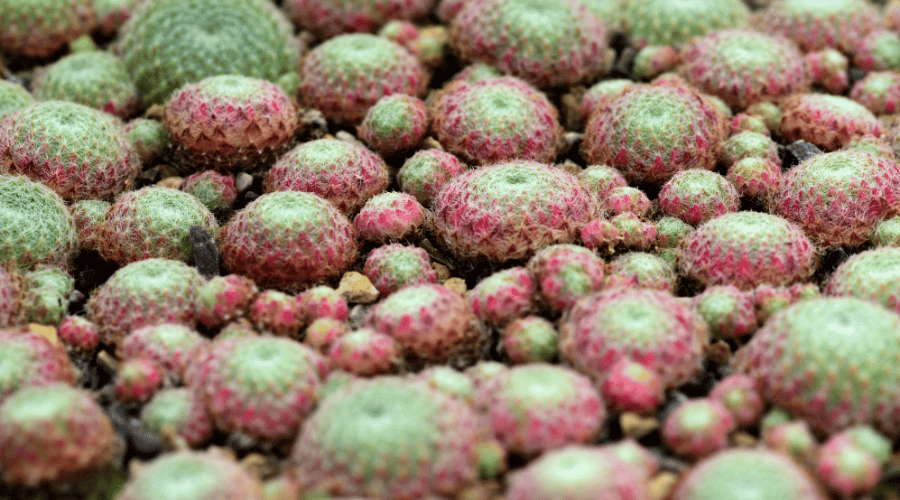
Here’s how to keep Teneriffe Houseleek healthy:
- Light: Place the Teneriffe Houseleek in a place with plenty of light. Indirect sunlight is ideal for Teneriffe Houseleek. It enjoys four to six hours of daylight each day. It can tolerate some direct sunlight, especially in cooler climates, but excessive exposure may cause leaf burn. In hot regions, partial shade or filtered sunlight are beneficial.
- Temperature: Teneriffe Houseleek has a low tolerance for cold and cold hardiness. It can tolerate low temperatures as low as -20°F (-29°C) and handle higher temperatures.
- Soil: You may use well-draining soil explicitly formulated for succulents or cacti. Teneriffe Houseleek can tolerate light acidic to mildly alkaline soils.
- Watering: Let the soil dry out between waterings when the soil’s top inch (2.5 cm) is dry. Avoid overwatering to prevent root rot. Water the plant less during the winter dormancy period.
- Humidity: Teneriffe Houseleek prefers drier environments with low humidity levels.
13. Vicks Plant (Plectranthus tomentosa)
If you want a fuzzy succulent indoor plant, Vicks Plant is unique! Vicks Plant has soft, fuzzy leaves that are grayish-green in color. The leaves are oval-shaped and slightly serrated along the edges. When rubbed or gently brushed, the leaves emit a pleasant fragrance reminiscent of Vicks VapoRub, which gives the plant its common name. It usually grows into a compact, bushy shrub that reaches a height of between 1 and 2 feet (30 to 60 cm). In addition to producing small clusters of lavender or purple flowers, it also has aromatic foliage that attracts much attention.

Here’s how to keep Vicks Plant healthy:
- Light: Indirect sunlight is ideal for Vicks Plants. At least four to six hours of sunlight are required to grow. While it tolerates some morning or evening sun, it may need protection from intense midday sun, especially in hotter climates. In regions with high temperatures, partial shade or filtered sunlight is beneficial.
- Temperature: Vicks Plant prefers average indoor temperatures between 60°F (15°C) and 75°F (24°C). It can tolerate a little cooler or warmer temperatures, but it may not have the strength to withstand frost.
- Soil: Mix potting soil and perlite or coarse sand so it drains well. The soil should retain some moisture but not become waterlogged.
- Watering: Vicks Plants need a moderate amount of water. Water them when the soil feels dry in the top inch, then let the excess water drain away. Overwatering can result in root rot. Reducing watering during the winter months is advisable to allow the plant to enter a period of dormancy.
- Humidity: A Vicks Plant tolerates any humidity level but prefers moderate moisture. It can survive in drier indoor environments as well.
14. Chenille Plant (Echeveria pulvinata)
Echeveria pulvinata has rosettes of thick, fleshy leaves covered in fine, soft hairs, giving them a fuzzy or velvety feel. Although ordinarily green in color, it can develop reddish or purplish tones under intense sunlight or stress. During the spring and summer, it can produce tall, arching flower stalks with small, bell-shaped, orange, or yellow flowers. The rosettes grow up to 6 inches (15 cm) in diameter.

Here’s how to keep Chenille Plant healthy:
- Light: Bright, indirect sunlight is perfect for Echeveria pulvinata. It needs at least four to six hours of daylight a day. Even though it can tolerate some direct sunlight, especially in cooler climates, excessive exposure to intense sun rays may burn its leaves. A little shade or filtered sun is excellent, especially in hot places.
- Temperature: You can grow Echeveria pulvinata in slightly warmer temperatures but may benefit from shade during the hottest months. Protect it from freezing temperatures, as it is not cold-hardy.
- Soil: The soil should be well-draining and specially formulated for succulents and cacti. Use a mixture of sandy or potting soil mixed with perlite or pumice.
- Watering: Echeveria pulvinata needs water like a succulent. Don’t overwater the plant during the winter, so let the soil dry out between waterings. Overwatering can lead to root rot, so don’t overwater it.
- Humidity: Echeveria pulvinata prefers low to moderate moisture and can tolerate drier air.
15. Fang (Kalanchoe beharensis)
Fang, or Kalanchoe beharensis, is a striking succulent native to Madagascar that belongs to the Crassulaceae family and has a distinctive appearance and large, fuzzy leaves.
Fang is a shrub-like succulent that can grow 6 to 10 feet (1.8 to 3 meters) in the right conditions. It’s covered in fine, silver-gray hairs and has a thick, woody stem. The leaves are scalloped and can get up to 6 inches long. It has a unique and attractive look because of its leaves.

Here’s how to keep Kalanchoe beharensis healthy:
- Light: Fang thrives in warm, arid climates. When grown indoors, place it near a south-facing window or a place with plenty of light shining bright indirect light on it.
- Temperature: As it is sensitive to frost, Fang prefers warm temperatures between 60°F and 85°F (15°C to 29°C). Protect it from freezing temperatures, as it cannot withstand frozen temperatures.
- Soil: To prevent waterlogging, you should provide Fang with well-draining soil, such as cactus or succulent mixes.
- Watering: Fang is drought tolerant, so water sparingly. Use soil that has dried out between waterings and be careful not to overwater. During the dormant winter, water less often.
- Humidity: Succulents like a medium humidity level in the environment but will thrive in drier conditions. Avoid placing them in humid areas.
16. Panda Plant (Kalanchoe Tomentosa)
Panda Plants are succulents native to Madagascar, named for their fuzzy, panda-like appearance. They are known scientifically as Kalanchoe tomentosa. Panda Plants grow in compact rosettes of leaves with a velvety texture and delicate, soft hair coverings. They have thick, fleshy leaves with a velvety texture and light, soft hairs covering the leaves. Besides being serrated, the leaf margins are brownish-red and chocolate-colored, while the upper surface is gray-green. It grows up to a height of one foot (30 centimeters) with dense white or silver hairs on the underside of the leaves.

Here’s how to keep Panda Plant healthy:
- Light: Ensure your Panda Plant receives plenty of bright, indirect light at least several hours daily. Avoid direct sunlight during hot summer afternoons, as direct sunlight can damage the leaves.
- Temperature: Generally, Panda Plants like to be between 60°F and 75°F (15°C to 24°C). They can tolerate slightly cooler temperatures but should be protected from frost.
- Soil: Using a succulent or cactus potting mix that drains well is essential. This type of soil prevents waterlogging and excess waterlogging.
- Watering: Allow the soil to dry out partially between waterings, but do not let it completely dry out. Reduce watering frequency during winter or dormancy periods.
- Humidity: These succulents can tolerate average indoor humidity but prefer drier conditions. They are well-suited for environments with low humidity.
17. Rogers’ Crassula (Crassula rogersii)
Known as Rogers’ Crassula or Baby’s Necklace, this compact, trailing succulent has small, round leaves that look great in any home. This plant has densely clustered leaves along its stems, making it look necklace-like. They have glossy, green or gray-green leaves with a glossy texture. Depending on the growing conditions, their leaves may turn reddish or purplish around the edges. A plant with enough sun may produce star-shaped white or pale pink flower clusters.
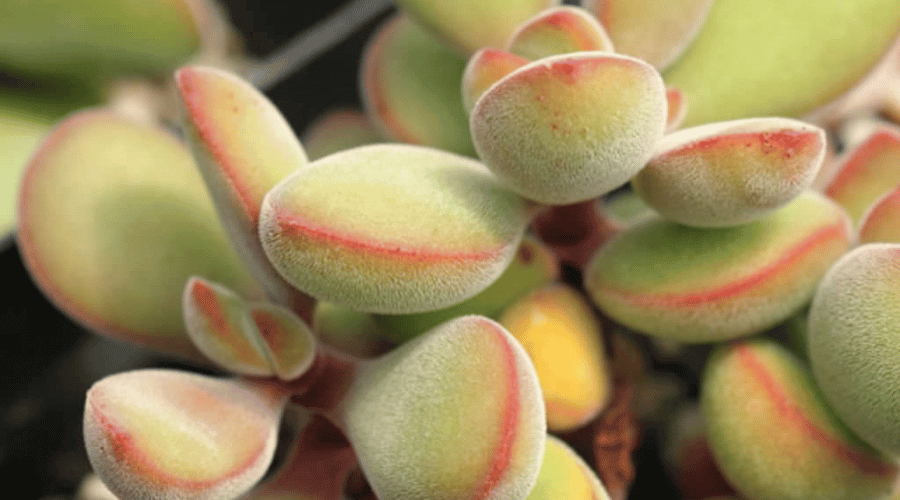
Here’s how to keep Crassula rogersii healthy:
- Light: Place it near a south-facing window indoors or add supplemental lights. It can tolerate some direct sunlight, especially in the morning or evening, but the intense midday sun may scorch the leaves.
- Temperature: This plant needs temperatures between 60°F and 80°F (15°C to 27°C). It’s tolerant of cooler temperatures, but it should be protected from frost.
- Soil: Suitable soil mix includes potting soil, sand, and perlite. The soil should allow excess water to drain quickly to prevent root rot.
- Watering: Plant Watering: Crassula rogersii has moderate water needs. Water thoroughly when the soil’s top inch (2.5 cm) feels dry. Allow the soil to dry out between waterings, as overwatering can lead to root rot. Reduce watering during winter.
- Humidity: This succulent is well-suited to low to moderate humidity levels.
18. Miniature Stonecrop (Sedum mocinianum)
The succulent sedum mocinianum belongs to the Crassulaceae family and originates in Mexico. It grows low, mat-forming, and often is called a “Miniature Stonecrop.” It also has powdery or waxy coatings on its leaves that keep them moist. Its rosettes can grow up to 2 inches (5 centimeters) in diameter, in addition to its compact rosettes of fleshy, round leaves. Miniature Stonecrop produces star-shaped white or pale pink flower clusters in the flowering season.

Here’s how to keep Miniature Stonecrop healthy:
- Light: Provide Sedum mocinianum with plenty of sunlight. It loves full to partial sun. If you’re growing it indoors, put it near a sunny window.
- Temperature: The perfect temperature for this succulent is between 50°F and 80°F (10°C to 27°C). It can tolerate slightly cooler or warmer temperatures but should be protected from frost.
- Soil: Use a mixture of regular potting soil, coarse sand, and perlite for Sedum mocinianum. Good drainage is crucial to prevent root rot.
- Watering: If the soil feels dry, water the plant thoroughly, and make sure excess water drains away. Sedums are drought-tolerant plants, so don’t overwater.
- Humidity: Sedum mocinianum can tolerate various humidity levels but prefers drier conditions. It is well-adapted to arid and semi-arid conditions.
19. Corsican Stonecrop (Sedum dasyphyllum)
The Corsican Stonecrop, scientifically known as Sedum dasyphyllum, is a small, fleshy succulent native to the Mediterranean region. The leaves are typically green or bluish-green in color and are densely arranged along the stem. The plant grows low, mats, and has small, fleshy leaves. They can have a fuzzy or velvety texture due to fine hairs covering the leaves. The plant has a cascading growth habit, with stems that reach 6 to 8 inches (15 to 20 centimeters). The plant produces clusters of yellowish-white flowers during the summer.

Here’s how to keep Corsican Stonecrop healthy:
- Light: When growing Corsican Stonecrop indoors, place it near a south-facing window or provide supplemental lighting. It thrives in full sun to partial shade.
- Temperature: You can keep this succulent in moderate temperatures between 60°F and 75°F (15°C to 24°C). It can go slightly cooler or warmer, but it’s best not to overheat it.
- Soil: Use perlite, coarse sand, and regular potting soil for Corsican Stonecrop. Good drainage is essential to avoid waterlogged roots.
- Watering: Let the soil dry out between waterings. The Corsican Stonecrop is a drought-tolerant plant that doesn’t need frequent watering. Water thoroughly when the soil’s top inch (2.5 centimeters) feels dry. Avoid overwatering as it can cause root rot.
- Humidity: This succulent can tolerate various humidity levels but prefers drier conditions. It is well-adapted to arid and semi-arid environments.
20. Thimble Jade (Crassula congesta)
The crassula congesta, also known as Thimble Jade or Watch Chain Crassula, is a small succulent plant native to South Africa. A mat-forming succulent, Crassula congesta has a unique growth pattern. Its leaves are fleshy, cylindrical and tightly overlapping along its stem, resembling beads or chains. In most cases, the leaves are green or gray-green, but they can develop red or purple tinges when exposed to bright sunlight or cool temperatures. Plants grow about 4-6 inches (10-15 centimeters) high and form dense clusters when they bloom. Flowers are star-shaped and white or pale pink.
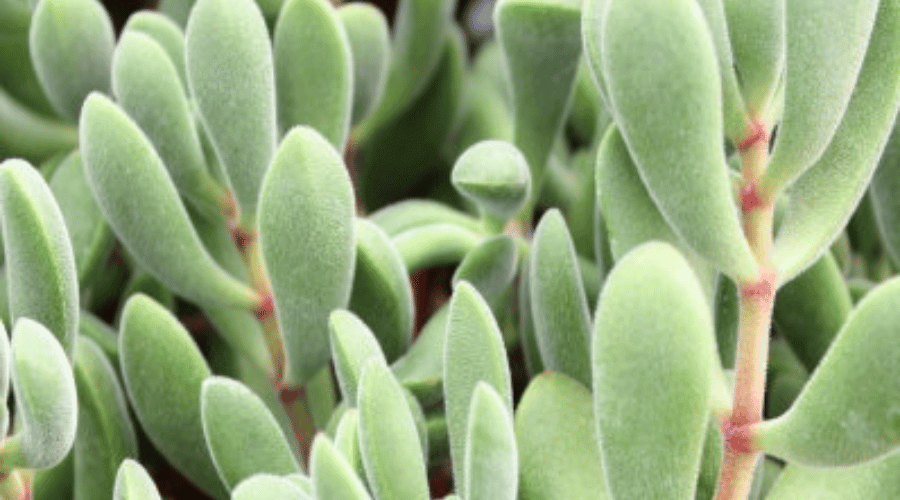
Here’s how to keep Thimble Jade healthy:
- Light: Crassula congesta prefers bright indirect sunlight or partial shade. While it tolerates some direct sunlight, its leaves can burn if this happens. Indoors, place it near a south-facing window or add supplemental light.
- Temperature: This succulent prefers moderate temperatures between 60°F and 80°F (15°C to 27°C). It can tolerate slightly cooler or warmer temperatures but avoid extremes.
- Soil: The best soil for crassula congesta is a mix of regular potting soil, sand, and perlite. Good drainage prevents soggy conditions that can lead to root rot.
- Watering: Let the soil dry out between waterings. Water the plant thoroughly once it feels dry, and let the excess water drain. Crassula congesta likes less water than most succulents but doesn’t mind a little less.
- Humidity: This succulent tolerates average indoor humidity levels. It is well-adapted to drier conditions and doesn’t need high humidity.
The fuzziness or hairiness on succulent plants is primarily caused by specialized structures called trichomes. Trichomes are tiny, hair-like projections on the plant’s leaves, stems, or other parts. Depending on the succulent species, these structures can vary in shape, size, and density.
Recent Posts
Unlocking the secret to expanding your begonia maculata family is like discovering a treasure trove of green goodness. If you've ever marveled at the stunning beauty of angel wing begonia leaves and...
If you've ever found yourself marveling at the surreal beauty of air plant blooms, you're in for a treat! These enchanting bursts of color amidst a sea of lush green foliage are like nature's way of...

